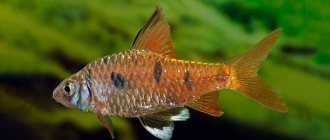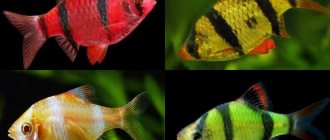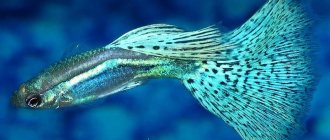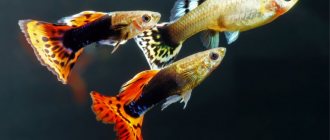Barbs are aquarium fish that naturally live in Africa, China and South Asia. There are quite a large number of their types. They are perfect for aquarists with little experience, as they are unpretentious and highly active. If your aquarium is already stocked, then you need to find out the compatibility of barbs with other fish. New tenants, if selected incorrectly, can put real pressure on the “old guys.”
To get to know brightly colored fish better, it’s worth getting to know their features and character better.
Appearance
The barb, which belongs to the carp family, in the wild can reach quite large sizes - 50 cm. Aquarium inhabitants do not have such sizes (the exception is the shark species, which grows up to 35 cm.) Their average size is 4 cm - 10 cm depending on the species .
The Sumatran barb is one of the most popular representatives of this species.
The yellow, slightly flat body with a silvery tint has black vertical stripes. Males can be recognized by the bright red edging on all fins except the paired ones. Females are characterized by larger parameters and less bright fins, and sometimes a complete lack of color.
Breeding work has led to a rich variation in the bright colors of this fish. For example, a beautiful emerald color was obtained for almost the entire body of a mutant barb.
Who do you get along with best?
As a conclusion, we can briefly list the best neighbors for Sumatrans and their immediate relatives.
Most suitable neighbors:
- catfish;
- zebrafish;
- battles;
- other barbs of the same size.
With caution, you can add apistograms, gourami and large swordtails.
Behavioral characteristics and character
It is a great pleasure to watch the daily adventures of cheerful fish actively displaying themselves in the aquarium. They get along well with fish of similar characters, but do not like slow ones. Little bullies will not be given rest by the owners of long and veil-like fins. Being 50% predatory, the barb often shows aggression, hunting for neighboring tails and fins and biting them. This feature determines the careful selection of possible neighbors for hooligan fish. Calmness and serenity are completely unusual for them. Predatory fish love to eat fry and fish smaller than themselves, so you need to keep them away from each other.
Do not keep more than 6 barbs in the aquarium. The fish will either sort things out among themselves, or in a united flock they will begin to poison the rest of the pets. If the flock of barbs is quite small, the aggression of the species will also be great.
Habitat
Barbs live in the waters of Africa and Asia; in the aquarium hobby, mainly representatives from Southeast Asia are represented. Wild populations of barbs were brought to some countries and, thanks to their hardiness, took root here without any problems. For example, some species can be found in the USA, Colombia, Australia, and Singapore.
General compatibility rules
Babrus compatibility table.
In general, peaceful barbs in certain circumstances show their harmful and aggressive character. To maintain order in the aquarium and avoid possible injuries during fights, you should:
- Buy a large, spacious aquarium. Due to lack of space, bullies will start fights with other inhabitants, trying to seize territory.
- Provide the aquarium with plants. When the little bastard starts pestering the rest of the fish, they will have the opportunity to hide.
- Purchase representatives of different species. In this case, showdowns will only take place within the species, and these fish know how to stand up for themselves.
- Protect viviparous fish, otherwise all the fry will be exterminated.
- Make sure there is enough food, otherwise the fish will start fighting for it.
- Delimit the habitat areas of barbs and fish with long fins.
- Do not keep with slow-moving fish.
- Do not allow smaller fish into the same tank with barbs..
If you follow all these provisions, then peace will reign in the aquarium, and the barbs will not create conflicts. However, all fish are unique and it is worth considering their characteristics separately.
Basic content rules
The variety of barbs is truly amazing. There are both small individuals and quite large specimens. Accordingly, you need to choose an aquarium based on the size of the fish in order to create the most favorable conditions for them.
If you keep standard-sized specimens, then a 50-liter aquarium is sufficient for one small school of fish. It is advisable that it be rectangular in shape, and it is also necessary to have a lid, because these fish are very active and can even jump out of the aquarium during their games.
Good compatibility
In order to create friendly neighbors, it is worth paying attention to fast fish: zebrafish, thornets, congos, cichlazomas, diamond tetras and most catfish (speckled, tarakatumami). Sedentary fish, on the contrary, should not be allowed near barbs. Due to their character and appearance, bots, gouramis and swordtails are also suitable.
Botsiya
These fish are similar in many ways to barbs. They are fast and hate long fins. However, the loachfish can become aggressive towards other fish if it is alone in the aquarium. To solve this problem, it is worth keeping them in small flocks.
Swordtails
An active fish that loves to move quickly. Its disadvantage is its large fins, which attract barbs. At the same time, barbs get along well with them in a common aquarium, since the speed of these fish exceeds the restless predators. However, do not forget about aquatic plants to create shelters.
Danio rerio
Active and fast fish that live in schools. The absence of long fins and high speed of movement help to avoid quarrels.
Catfish
Due to the fact that barbs usually live in the upper or middle water layer, and catfish prefer a calm bottom, these fish do not have conflicts.
Gourami
Gourami is superior in size to barbs. The calmness and mobility characteristic of this fish helps it get along with these fidgets. However, you shouldn’t keep these fish with Sumatran fish, but the peace-loving cherry fish are perfect. It is also better to add the youngest representatives of the barb species to the gouras.
Barbs of different types
The best choice is to keep several types of barbs together (Sumatran and fire or cherry). The most peaceful and calm representative of the family is the green barb.
Short description
Appearance
Different types of barbs differ greatly in appearance.
Let's look at the main subspecies:
- Shark's. It is very different from other types, has an elongated body shape, gray scales and triangular fins, which is very reminiscent of a small shark. Pets can grow up to 20-25 centimeters.
- Cross. The body is slightly elongated, reaching 12 centimeters in length. The back is olive, brown or dull orange, the belly is brown and golden.
- Sumatran. The most popular species for keeping in an aquarium. The body is diamond-shaped, the color is light yellow, white or golden with large vertical stripes of black. The fins may be scarlet or bright orange. Length – 5-6 centimeters. The Sumatran barb is very popular; its maintenance is considered one of the simplest.
- Five stripe. Very similar to the previous species, only the stripes are thinner and more frequent, like a zebra.
- Fiery. The body shape is diamond-shaped, the color is uniform pink-red. Males are much brighter than females. Can reach eight centimeters. As with all varieties, the caudal fin is two-lobed.
- Green. Relatively large - nine centimeters. A characteristic feature is the green and olive color, which is considered very rare. The body is more elongated and rounded than that of the Sumatran species.
You can purchase several types of barbs of the same size at once if you cannot decide among the variety of colors and shapes. You can look at the photo to learn how to identify closely related species.
Habitat in nature
Distributed in Africa, South and Southeast Asia. Representatives of the genus live almost everywhere in the region in bodies of water with little current or standing water. They adapt very well to environmental conditions, so they can withstand sudden changes in water parameters.
Conditions for keeping
Neighboring fish must withstand the same conditions. Temperature, acidity and other characteristics must be optimal for all inhabitants of the aquarium without exception, even for aquatic plants. The most popular is the Sumatran barb: keeping this species is accessible even to novice aquarists.
Choosing an aquarium
Barbs need a large housing. Considering that these fish live in schools, you need at least 120 liters for 6 individuals. Fish love to swim, so it is better to choose an oblong shaped aquarium. The soil can be used in any color (this is not important for fish), so many people advise purchasing a dark substrate in order to advantageously emphasize the variegation of barbs.
To ensure that the fish have plenty of space to swim freely, it is better not to place large decorations or snags. Tall plants also interfere with frolic, so preference should be given to low-growing types of vegetation.
Water parameters
This species is considered very hardy, so it is better not to house them with sissy fish, which can hardly withstand changes in the surrounding water parameters.
The following conditions are considered optimal:
- water temperature – 20-25 °C;
- acidity – 6.5-7.5 pH;
- hardness – 5-10 dH.
Additional aeration and artificial creation of flow into the aquarium are not required.
Feed
Barbs are very small, so even with all their desire they will not be able to eat an adult fish of another species. They are considered omnivores. The diet may include frozen, dried, granulated and live foods. From animal food you need to give tubifex, bloodworms, daphnia, brine shrimp, cyclops.
To prevent adults from picking off plants, you need to give them finely chopped lettuce and dandelion leaves, nettles, spinach, wolfberry, dried seaweed, cucumbers and even zucchini. Like all fish, overfeeding Sumatran and other subspecies is strictly prohibited.
Poor compatibility
It is not recommended to add slow-moving fish to barbs: bettas, lalius, angelfish. There are also much more aggressive aquarium fish that should be kept separately, for example, Astronotus. It is also better not to keep them with goldfish, since tropical fish, in addition to their “defiant” appearance, need water at a completely different temperature. Shrimp and barbs don't always get along well either. Sumatran fish can destroy small shrimp, but if the shrimp themselves are large in size and are predators, then the danger will be on their part.
Angelfish
Slow fish with large fins will definitely be attacked by insidious semi-predators. Nevertheless, some aquarists keep them quite successfully. This requires some conditions:
- an aquarium with a volume of at least 100 liters;
- a small number of barbs;
- large and adult angelfish;
- grow together;
- First put the angelfish in the aquarium.
Cockerels
They have a cocky character, beautiful fins and a long tail. When living together, cockerels and barbs will have constant fights, in which beautiful fish will lose their fins.
Guppy
Those with long fins will quickly lose them. Attacks from barbs can lead to the death of fish. Long fins will be bitten, which can lead to death.
Lyalius
The inactivity and timidity of the fish will be happily accepted by the barbs, which will not give them peace.
Astronotuses
A fish that is large in size and aggressive in nature will definitely not get along with a barb.
Cichlids
The most aggressive aquarium fish. True predators, they get along calmly only with catfish. Barbs and cichlids can only be compatible if the latter are still small, but adults need to be removed, as they will definitely try to take over the territory.
Neons
In order for neons and barbs to exist peacefully, it is better to keep them in a spacious aquarium with plenty of hiding places. To be with them, choose the most peaceful ones - cherry or green barbs. It is better to introduce barbs to neons when they are still young.
Breeding Barbs
Aquarium preparation
If we consider a species such as the Sumatran barb, reproduction is relatively easy. Breeding in a community aquarium is possible, but involves a number of difficulties. For a long time, the temperature should be stable and be 22-23 °C, which is not always suitable for the barbs’ neighbors. In addition, “minke whales” deposit a lot of reproductive products, as a result of which the turbidity of the water can greatly increase.
It is better to transplant the producers into the spawning area. The container must have a volume of at least 8-10 liters and be made of glass. The water level is 25-30 centimeters. The bottom must first be disinfected and a fine-mesh mesh made of nylon or other inert material should be placed instead of soil. This will help protect the eggs from being eaten by the parents.
Water parameters should be as follows:
- acidity – 6.0 pH;
- the temperature is 22-23 °C, to stimulate spawning you need to raise it to 25-26 °C.
Before spawning, the parents need to be seated and intensively fed: males with protein food, females with plant food. Readiness for reproduction can be determined by the enlargement of the abdomen in both sexes; in females it becomes very large and rounded. Naturally, during this period, the “minke whales” do not tolerate any neighbors, because they become aggressive and nervous.
Spawning and nursing
Spawning of Sumatran barbs and their closest relatives occurs according to a general pattern. The fish are placed in the spawning tank in the evening, and early in the morning at sunrise they begin to spawn. Spawning lasts 2-3 hours, during which time the female manages to lay 500-600 eggs. After spawning, the parents should be immediately removed - into a common aquarium or separate containers - and a third of the water in the spawning tank should be replaced with fresh water.
To prevent fungus from appearing on the eggs, you can use methylene blue strictly according to the instructions. After twelve hours, it is recommended to remove unfertilized eggs so that they do not rot and cause the death of the entire clutch. The presence of green algae can also propagate the fungus, so you need to carefully monitor the condition of the aquarium for the fry.
After two or three days, the larvae hatch and begin to swim independently only on the fourth day. They need to be fed frequently (every 3-4 hours) with ciliates and nauplii of crustaceans, and periodically carry out partial water changes. Only after three to four months can adolescents be placed in a common aquarium with calm, slow neighbors, for example, catfish.
Features of sharing with fry
It is not for nothing that this species is considered bully: before introducing other fish, barbs must be divided into small groups of 6-10 individuals. If the fry live in the same large school as at the beginning of their lives, they will offend all the fish without exception.
As a rule, if you add even teenagers to young animals - zebrafish, bots or swordtails - the fish will get along well all their lives. Obviously, you cannot place little “minke whales” with bad neighbors - they will be eaten by predators.
Feeding
Barbs are omnivorous and absolutely unpretentious in their choice of food. They can be given any live (bloodworms, daphnia, tubifex, cyclops, Artemia nauplii and others) and frozen food.
Dry granulated factory formulations, which also contain plant components, are well suited. Otherwise, aquatic plants will be eaten.
These fish are voracious, they eat both from the surface and look for leftover food in the ground. You should feed them twice a day, but in small portions so as not to clog the pond.
Conclusion
Barbus is an unpretentious fish, suitable for both novice aquarists and professionals. It looks great with other types of fish, but they need to be chosen very carefully. It is advisable not to place them with viviparous animals (especially guppies, which are quite shy). An exception may be: mollies, platies and swordtails, as they are fast enough to resist bullies.
You need to plant enough vegetation in the aquarium so that other fish or the barbs themselves can hide. There should also be good flow and aeration, which will simulate the natural habitat of fish. Be sure to change the water every week and maintain a constant temperature.











